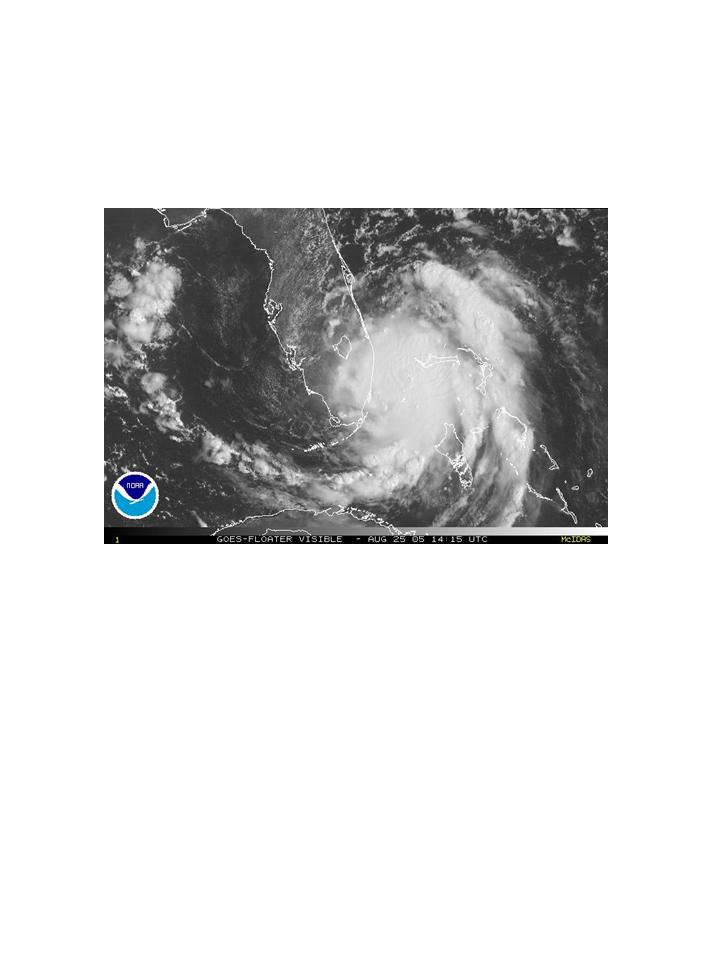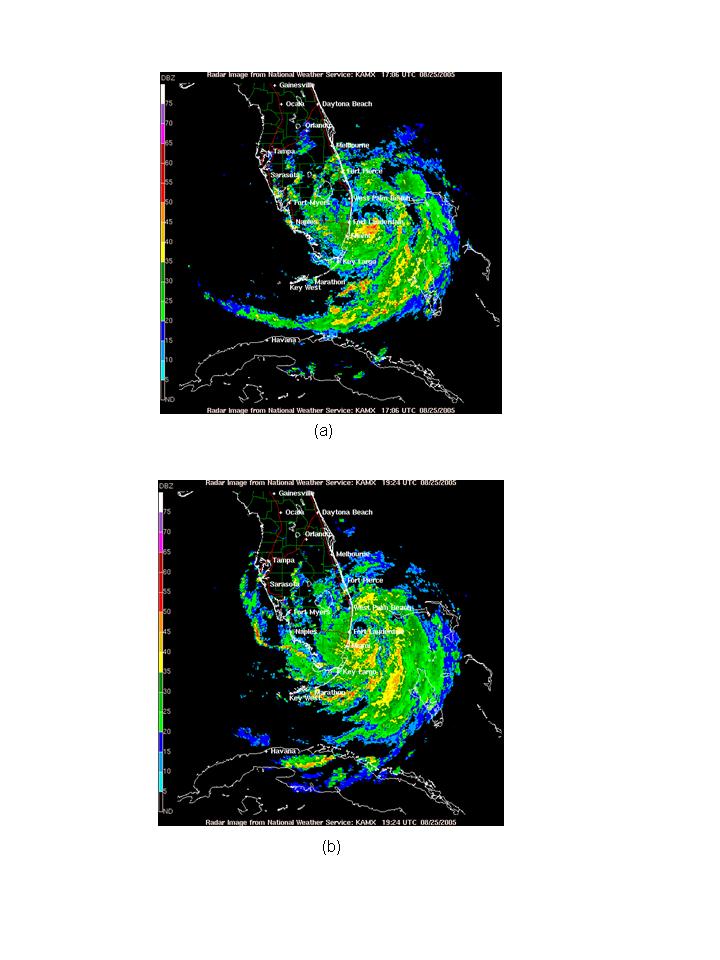IFEX daily log
Thursday, August 25, 2005
Tropical Storm Katrina continues to get better organized. At 12 UTC the storm
was located about 80 nm east southeast of Fort Lauderdale. Ground-based radar showed
convection concentrated on the east and south sides of the storm. N43RF was tasked for
a combination SFMR/fix mission, takeoff time scheduled for 1330 UTC. Because of a
computer malfunction, no air force planes flew into Katrina during the previous night, so
the takeoff for N43RF was pushed earlier to 1300 UTC. N42RF was down for continued
IWRAP installation.
The plan called for N43RF to perform its tasked pattern, and the NRL P-3 would
join N43RF toward the end of the mission to fly coordinated passes along a rainband.
The pattern for N43RF would be set up to allow for a downwind leg along a rainband that
would be targeted for coordination. Inspection of radar imagery in the morning before
takeoff indicated a possible target area to the northeast of the storm. The downwind leg
of focus would be oriented northwest-southeast from east of the storm to north of the
storm.
The NOAA mission proceeded fine. All instruments performed well, except for
some occasional communications problems between the AVAPS and HAPS data systems
for dropsonde processing. There was also a high dropsonde failure rate (50%). The
SMFRs performed well, as did the radars and the cloud physics probes. We were able to
access the RAMSDIS server and upload satellite loops to the aircraft, and we were also
able to process and transmit dual-Doppler radar analysis products off the aircraft in near
real-time. The coordination with the NRL P-3 did not occur, however, because of
maintenance issues with the NRL P-3.
 The storm became much better organized while N43RF was in it. Visible satellite
imagery at 1415 UTC (Fig. 31) showed two large rainbands developing, one oriented
around the north and east side of the storm and another wrapping around the south and
west side of the storm. There was a gap between the core cloudiness and the east
rainband. This band was being considered as a possible coordination target for the NRL
P-3, though it likely would have been too far from the center to be of interest. The visible
image appeared to show convective elements in the downwind portion of the band and
more stratiform elements in the upwind portion. Maximum flight-level winds during the
mission reached 75-80 kt on the east side, while maximum surface winds from the SFMR
were about 65 kt. The minimum sea-level pressure dropped to 985 hPa from a GPS
sonde.
The storm became much better organized while N43RF was in it. Visible satellite
imagery at 1415 UTC (Fig. 31) showed two large rainbands developing, one oriented
around the north and east side of the storm and another wrapping around the south and
west side of the storm. There was a gap between the core cloudiness and the east
rainband. This band was being considered as a possible coordination target for the NRL
P-3, though it likely would have been too far from the center to be of interest. The visible
image appeared to show convective elements in the downwind portion of the band and
more stratiform elements in the upwind portion. Maximum flight-level winds during the
mission reached 75-80 kt on the east side, while maximum surface winds from the SFMR
were about 65 kt. The minimum sea-level pressure dropped to 985 hPa from a GPS
sonde.
 The radar presentation also improved significantly while the aircraft was in the
storm. At 1706 UTC (Fig. 32a) there was a region of deep convection on the south side
of the circulation center. North-south oriented bands were also evident on the east and
south side of the storm. By 1924 UTC (Fig. 32b) a clear eye had formed on the radar
image, as convection had nearly encircled the center. The storm was just offshore Fort
Lauderdale at this time. Because of observations from N43RF, plus Doppler winds from
the ground radar, NHC upgraded Katrina to a hurricane.
The radar presentation also improved significantly while the aircraft was in the
storm. At 1706 UTC (Fig. 32a) there was a region of deep convection on the south side
of the circulation center. North-south oriented bands were also evident on the east and
south side of the storm. By 1924 UTC (Fig. 32b) a clear eye had formed on the radar
image, as convection had nearly encircled the center. The storm was just offshore Fort
Lauderdale at this time. Because of observations from N43RF, plus Doppler winds from
the ground radar, NHC upgraded Katrina to a hurricane.
The storm is forecast to continue moving slowly westward across the peninsula,
emerging into the Gulf of Mexico sometime during the weekend. Depending on where
the storm emerges and its expected track, this may reintensify into a significant hurricane
which would be a prime target for RAINEX missions. Elsewhere, a tropical wave in the
central Atlantic continues to be an area of interest. Its movement is toward the west and
it is expected to move west or west-northwest over the next several days. This could be
another possible target if it stays far enough south.
Rob Rogers
HRD Field Program director
Return to IFEX calendar page
![[Atlantic Oceanographic and Meteorological Laboratory]](../../../hrd_top_logo7.jpg)
![[OAR/DOC/NOAA Logos]](../../../oar_noaa_doc_logos3.jpg)